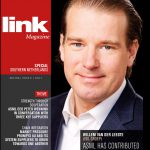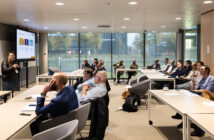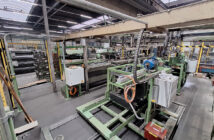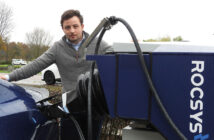Innovation is exhilarating. But there are ways of getting more of a grip on things. That’s when what was once thought impossible becomes a reality, such as perfectly autonomous cars or 3D spectacle lenses with wonderful applications. To mention just a couple of examples from the Link Café. That meeting was held in the former Honig soup factory in Nijmegen at the end of March. ‘Totally new players have a great deal of influence on what our market looks like.’

Maurice Geraets, Managing Director of NXP Netherlands: ‘Beating a Formula 1 driver like Verstappen with an autonomous car is a major challenge that would take the technology to its outermost limits’.
Could you ever see Max Verstappen driving an automated guided vehicle?
‘Would you have done the same?’
Could you ever see Max Verstappen driving an autonomous car? That question is put to Maurice Geraets, Managing Director of NXP Netherlands, at the end of his presentation. Sure, is his response. He once heard Max and former top driver Jan Lammers talking about it. Lammers would rather have the total certainty of driving himself, he stated. Verstappen was a little more laconic. Driving on a Dutch motorway isn’t really driving anyway, so why not let that be done automatically, he said. Obviously Verstappen would rather have the steering wheel firmly in his own two hands on the racetrack. ‘But how long will it be until Verstappen is beaten by a self-driving car?’, wonders one of the 60 or so participants from industry and professional services. Quite some time yet, Maurice Geraets estimates. No two autonomous cars are the same. It is still possible to develop a car that will function pretty well automatically on the motorway and prevent collisions. ‘Beating a Formula 1 driver like Verstappen with an autonomous car is a major challenge that would take the technology to its outermost limits. That final 10 percent automation is 100 times harder than the first 90 percent. But it should happen sometime between 2030 and 2035. But who knows, perhaps we’ll end up with completely different concepts than are conceivable at present. That would see us driving completely autonomously to Amsterdam – not to the city centre but to the RAI congress centre on the outskirts, for instance – thus avoiding the really big, challenging routes through a global city.’ Smart people movers will then take people into the city centre.
Chips, an awful lot of chips
Chip producer NXP (9.4 billion dollars annual turnover worldwide, 30,000 staff, including 3,000 in the Netherlands) has been fully independent from its former parent company Philips for around 13 years now. Its site in Nijmegen has a 66-year history of production and innovation. ‘Nijmegen is our biggest and best factory’, says Maurice Geraets. NXP has invested tens of millions in it in recent years. NXP sees numerous social challenges and opportunities to home in on using electronics. Artificial intelligence, Internet of Things, connectivity, machine learning, edge computing, he says, listing the associated terms. That will call for smart chips for cloud solutions and devices. An awful lot of chips.
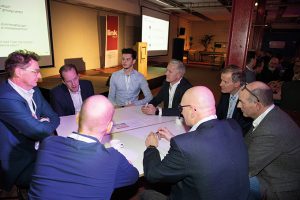
Maurice Geraets, Managing Director of NXP Netherlands: ‘Beating a Formula 1 driver like Verstappen with an autonomous car is a major challenge that would take the technology to its outermost limits’.
The number of transistors on a square centimetre chip doubles every 18 months, so either an electronic product halves in price or it can do twice as much. Those chips will equip the cars of the future with human eyes and ears, and they’ll be connected to one another and the Internet, be given camera functionality, become electric. ‘Not merely from the perspective of a technology push, but because this will see the industry addressing the challenges in the world, such as cleaner air, safer driving and greater attention to sustainability.’ The 380 dollars’ worth of chips currently in a car on average is set to increase dramatically, insists Geraets. ‘An autonomous car at level five is the ultimate goal. Level two is what you see in clips on the motorway now. They contain hundreds of dollars’ worth of extra chips. That presents a huge opportunity for us, though also a great deal of responsibility.’
Crossing in an orderly fashion
NXP Semiconductors is the world’s number one in chips for cars. If the market mushrooms, then the company will need to invest heavily in order to defend or even expand on that position. NXP Eindhoven and Nijmegen spend a quarter of a billion dollars a year on their R&D. Autonomous driving calls for interplay between a large number of parties, including entirely new ones: Google with its Internet, Rijkswaterstaat, which will need to invest in technology capable of understanding those autonomous cars. Alibaba has Alicloud, a cloud platform for car entertainment. ‘These totally new players have a great deal of influence on what our market looks like. We need to get involved. The complexity is huge.’ Maurice Geraets shows a clip of a car righting itself on a slippery road surface fully automatically. As well as cars that communicate with one another and simultaneously cross a junction unmanned and without colliding. That’s not so much to do with AI or sensors, but rather with them simply telling each other what their intention is and negotiating priority. ‘It’ll be a fairly long time until this is possible, because that standardisation of communication between cars is around already, but only for simple information and it isn’t yet transferable across the plethora of brands that exist.’
Retrofit does not exist
The big question is what could be done to expedite the autonomous driving market. It has a positive impact on road safety, on emissions, on road use. NXP is keen to solve social problems more rapidly and at the same time get more business from it. ‘When you look at the total chaos that exists on Vietnamese streets, then you’re forced to recognise that self-driving cars are still a long way away from coping with something like that. But on the other hand, you’d have had dozens of coaches and one car driving on 5th Avenue in New York back in 1900. A decade or so later the opposite was the case. More change will come in the automotive sector over the next decade than has come over the past 50 years.’
We do, of course, have a legacy on our hands: the average car in the Netherlands is now 10 years old and there are no retrofit solutions to incorporate autonomous driving technology. But there’s no need to panic now, as if 15 percent are capable of autonomous driving then that will already have a tremendous effect. After all, the traffic between these vehicles will adapt to those cars optimising their behaviour. Legislation will also need to move with the times. And then there will be many people who are opposed to autonomous driving or the vast quantities of data collection surrounding it. An idea from the audience: ‘Maybe we should completely write off one generation for autonomous driving: those people fixated on driving themselves.’
Layer by layer
Speaker Joost van Abeelen, COO of Luxexcel, is faced with significant innovation issues of a completely different sort, he says. Luxexcel was founded 10 years ago around a unique technology to make transparent components on a 3D printer. The company initially focused on any and every market dealing with those types of component, but is now concentrating on spectacle lenses. ‘Two questions are always put to us: how can you print a transparent lens at all? Well, using printer heads that build up the lens with really fine droplets layer by layer. The material we use has great properties for the ophthalmic industry, including the correct refractive index. And very importantly: no finishing work is necessary. Straight away what comes out the printer is the correct prescription and doesn’t need to be polished’, says Van Abeelen, who passes a sample round the room as proof. The second question put to him: is it the real deal? ‘Absolutely. We’re already printing lenses for the commercial market in the US.’
Flying under the radar
That ophthalmic industry is big: at the end of the day, 60 percent of all people need eye correction, at an ever younger age. This is a mass customisation product. Each and every lens is tailor-made and that is exceptionally interesting for 3D printing. ‘The sale price of a lens varies from double figures to hundreds of euros. The wider market is served by Specsavers, Kruidvat, with their reading glasses, sunglasses as well as varifocals. We’re talking a maximum of 25 euros per lens for the manufacturer. That market inundated with major players and small margins isn’t an interesting one to start out in.’ Which is why Luxexcel chose the ophthalmic specials. Everything beyond a prescription of minus six and plus six is not a mass market. The prices are a good deal higher. ‘Great for us to test the water. And we can fly under the radar somewhat, as the big boys aren’t as interested in this segment. We started out with special lenses – with a high prismatic power, for instance. Or a pair of spectacles for a pilot, with a reading segment at the top rather than at the bottom. An optician orders lenses from a lab that makes them. So that’s where we position our printers. We do things on a pay-per-print basis, in order to ensure our new technology succeeds without investing too much in a lab.’
So it is a great technology, but all you are actually doing is replacing a current method of production, acknowledges Van Abeelen. Which is why Luxexcel started exploring the question: what could be possible that is not currently possible? ‘We started talking to people from other segments, looking for possible combinations. If you’re printing lenses, then could you stick another layer in between? Foil, for instance, which you could activate with a battery to turn your glasses into a pair of sunglasses just like that. Or a waveguide for augmented reality. There’s plenty of potential for AR, but not with those huge goggles on your head. A pair of glasses has now been developed for use in warehouses and the medical sector, with information being plotted on the lens. We take care of the lens prescription. That’s something that has us working flat out. The waveguide will be something for a partner to do.’
Major quest
What is the way forward, Van Abeelen asks the room. ‘We’re busy bringing that 3D technology to the optical lens market. We’re focusing on low-volume, high-value products first so as to prove the technology. We’re a sexy start-up, but we’ll always need to work with partners with access to the end customer. And additional technologies will have to come from technology partners. It’s a major quest. Would you have done the same? Or would you instead have chosen that mass market? The current industry will always be able to outperform us. We’re the newcomers who still have a lot to learn.’
Ad van Berlo responds: ‘Respect for you as a bona fide tech start-up. But how can such a printed lens genuinely benefit the consumer? Approach the user. Find out where the added value lies and look for a printer to suit that—not the other way round.’
Another suggestion from the audience: ‘Be a one-stop shop: the customer gets his eyes tested and says straight off what AR he wants added and then you just go ahead and print.’ Or license the technology for use by other parties. This is definitely something Luxexcel is considering, continues Van Abeelen.

Ad van Berlo, a professor at Eindhoven University of Technology and founder of innovative design bureau VanBerlo in Eindhoven: ‘Distinguishing oneself by means of material value isn’t everything. What’s your immaterial value like?’
Are you relevant?
Ad van Berlo, a professor at Eindhoven University of Technology and founder of innovative design bureau VanBerlo in Eindhoven, and his colleague Bart Versteeg have done a lot of research in conjunction with TIAS into design-driven innovation and so-called Creative Equity (measuring capacity for innovation). The user plays a key role with all his demands and requirements. Van Berlo: ‘The world is complex and dynamic. How do you keep up as an entrepreneur? We’ve got to continuously transform and innovate, but what you produce does actually need to work. We’re very much an advocate of open innovation. Not because it’s so fun and easy, but quite simply because companies need each other. Cooperate in clear alliances.’
Change isn’t about me, myself and I, he adds. McKinsey surveyed 2,200 CEOs and – lamentably – just 6 percent of them are happy with their company’s own development and innovation. Worse still, they don’t really know what the root cause is.
Van Berlo has one important question for the entrepreneur: how will you stay relevant with your products over the next few years? ‘Ostensibly a simple question. Look at three things: what are the capabilities of your staff like, the skills to develop? Is there a culture of innovation? And do you have a well-honed proposition: who are your customers, are you competitive?’ It’s about creating value. Distinguishing oneself by means of material value isn’t everything. What’s your immaterial value like: how are you framing and positioning yourself, what’s your drive, what do you believe in?’ Look at things from the perspective of the user: what does he need, how can the business adapt to meet that need?

Bart Versteeg, innovation strategist (in shirt): ‘If you know what you’re doing, then innovation really isn’t all that complicated’.
Innovation Engine
‘At VanBerlo, we know how a company can lend its innovation structure’, says innovation strategist Bart Versteeg. Innovation is regarded as something vague, the fuzzy front end. ‘But if you know what you’re doing, then innovation really isn’t all that complicated.’ He shows a slide of the Innovation Engine: an innovation strategy is crucial, as is an innovation portfolio (where are your markets and customers?) and innovation processes (how do you structure your processes within the company?) and the innovation practice (what methods are you using?). And do you have your innovation governance in order? What measuring points are relevant?
Bart Versteeg could keep listing questions: do people feel safe and free to put forward ideas? Is the company integrated within networks? These are often soft values, but they are extremely important. ‘If your innovation climate is poor, then your company isn’t innovative at all. Is there an opportunity to go against the grain or does nobody ever cast a critical eye over things.’ And note his words: if a company’s vision isn’t clear, then nothing new will ever be created.
Fifth edition Link Café
Link Magazine’s fifth Link Café, sponsored by Siemens Industry Software and Berenschot, was held in Nijmegen at the end of March, in an old factory where Honig used to make its soups. This time round, the Industriële Kring voor Nijmegen en Omgeving was involved in organising the Link Café. The theme: ‘the necessity of innovation and the structures thereof’.
Between the speeches the participants came to the table in an informal atmosphere and discussed questions presented by the speakers. In excess of 60 OEMs and suppliers attended the event. Joes Wigman, Managing Director of the Operations advisory group at Berenschot, conducted the afternoon session.


